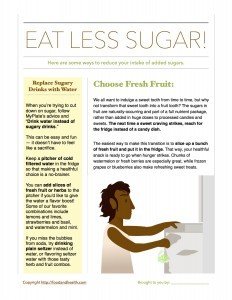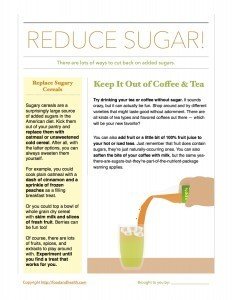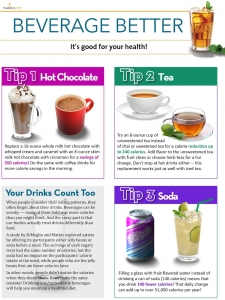Cut Down on Sugar: A Strategy Guide
Do you remember that sweetener chart that I posted a few weeks ago? So many of you wrote with follow-up questions and thoughts -- I was blown away by your response. I really want to address everything we discussed, so my team and I have put together a blog series on sweeteners. Today will be the first post, and it's all about ways to cut down on added sugars... Added Sugar Reduction Tip #1: Replace Sugary Drinks with WaterWe've shared this tip before, but it's so important that it bears repeating. When you're trying to cut down on sugar, follow MyPlate's advice and "Drink water instead of sugary drinks."This can be easy and fun -- it doesn't have to feel like a sacrifice. Keep a pitcher of cold filtered water in the fridge so that making a healthful choice is a no-brainer. You can add slices of fresh fruit or herbs to the pitcher if you'd like to give the water a flavor boost! Some of our favorite combinations include lemons and limes, strawberries and basil, and watermelon and mint. If you miss the bubbles from soda, try drinking plain seltzer instead of water, or flavoring seltzer water with those tasty herb and fruit combos.
Added Sugar Reduction Tip #1: Replace Sugary Drinks with WaterWe've shared this tip before, but it's so important that it bears repeating. When you're trying to cut down on sugar, follow MyPlate's advice and "Drink water instead of sugary drinks."This can be easy and fun -- it doesn't have to feel like a sacrifice. Keep a pitcher of cold filtered water in the fridge so that making a healthful choice is a no-brainer. You can add slices of fresh fruit or herbs to the pitcher if you'd like to give the water a flavor boost! Some of our favorite combinations include lemons and limes, strawberries and basil, and watermelon and mint. If you miss the bubbles from soda, try drinking plain seltzer instead of water, or flavoring seltzer water with those tasty herb and fruit combos. Added Sugar Reduction Tip #2: Snack on Fresh Fruit Instead of CandyWe all want to indulge a sweet tooth from time to time, but why not transform that sweet tooth into a fruit tooth? The sugars in fruit are naturally-occurring and part of a full nutrient package, rather than added in huge doses to processed candies and sweets. The next time a sweet craving strikes, reach for the fridge instead of a candy dish.The easiest way to make this transition is to slice up a bunch of fresh fruit and put it in the fridge. That way, your healthful snack is ready to go when hunger strikes. Chunks of watermelon or fresh berries are especially great stand-ins for candy. Frozen grapes or blueberries also make intriguing and refreshing sweet treats.If you're snacking on the go, consider stashing some bananas and apples in your car -- they're sturdy and hold up well outside the fridge for a while.
Added Sugar Reduction Tip #2: Snack on Fresh Fruit Instead of CandyWe all want to indulge a sweet tooth from time to time, but why not transform that sweet tooth into a fruit tooth? The sugars in fruit are naturally-occurring and part of a full nutrient package, rather than added in huge doses to processed candies and sweets. The next time a sweet craving strikes, reach for the fridge instead of a candy dish.The easiest way to make this transition is to slice up a bunch of fresh fruit and put it in the fridge. That way, your healthful snack is ready to go when hunger strikes. Chunks of watermelon or fresh berries are especially great stand-ins for candy. Frozen grapes or blueberries also make intriguing and refreshing sweet treats.If you're snacking on the go, consider stashing some bananas and apples in your car -- they're sturdy and hold up well outside the fridge for a while. Added Sugar Reduction Tip #3: Check the FactsThe Dietary Guidelines for Americans advise people to "Read the Nutrition Facts label for information on the sodium content of foods and purchase foods that are low in sodium." This advice will also stand you in good stead when it comes to reducing added sugars.Of course, the added sugar content isn't on the Nutrition Facts Label (yet!), so you would need to check the ingredient list instead. Since ingredients in processed foods are listed from most to least, you can see which items have a disproportionate level of added sugars. When comparing foods, try to choose an option with less added sugar.Oh! And beware of sneaky labeling. Some manufacturers use several different types of sugar to sweeten a product so that sugar won't be one of the top ingredients listed. Get familiar with the different types of and names for sweeteners by revisiting the Sweetener Chart post that started it all!If you'd like to offer your clients some of these great tips, you're in luck! Here's a free handout that covers key strategies from this post.
Added Sugar Reduction Tip #3: Check the FactsThe Dietary Guidelines for Americans advise people to "Read the Nutrition Facts label for information on the sodium content of foods and purchase foods that are low in sodium." This advice will also stand you in good stead when it comes to reducing added sugars.Of course, the added sugar content isn't on the Nutrition Facts Label (yet!), so you would need to check the ingredient list instead. Since ingredients in processed foods are listed from most to least, you can see which items have a disproportionate level of added sugars. When comparing foods, try to choose an option with less added sugar.Oh! And beware of sneaky labeling. Some manufacturers use several different types of sugar to sweeten a product so that sugar won't be one of the top ingredients listed. Get familiar with the different types of and names for sweeteners by revisiting the Sweetener Chart post that started it all!If you'd like to offer your clients some of these great tips, you're in luck! Here's a free handout that covers key strategies from this post. Looking for more sugar-reduction tips? Drop by the member-exclusive post More Ways to Reduce Sugar Consumption for another great handout and additional fun ideas.
Looking for more sugar-reduction tips? Drop by the member-exclusive post More Ways to Reduce Sugar Consumption for another great handout and additional fun ideas. There are lots of other ways to help your clients improve their eating habits! Visit the Nutrition Education Store for some of these popular resources...
There are lots of other ways to help your clients improve their eating habits! Visit the Nutrition Education Store for some of these popular resources...
 We're here to help you look your very best, right now!
We're here to help you look your very best, right now!


